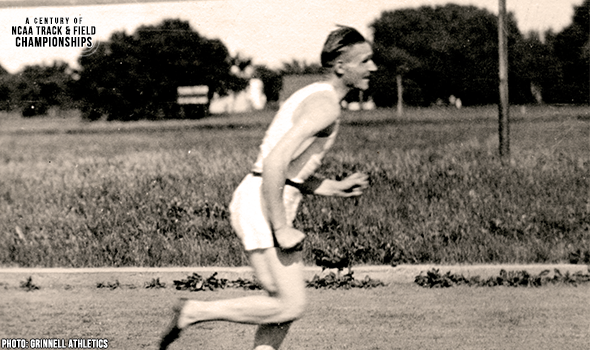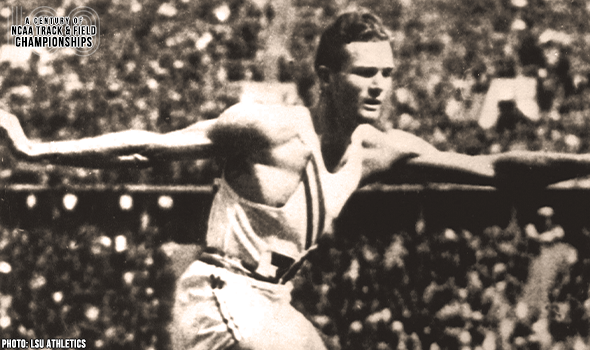
X-Man Reigned At 2006 NCAA Meet
The X-Men are fictional superheroes.
The X-Man, however, is very, very real.
Back in 2006, Xavier Carter authored comic-book-like performances at the NCAA Division I Outdoor Track & Field Championships in Sacramento, California, when he became the first man since Jesse Owens to win four national titles at the same outdoor meet and completed the only 100-400 double in meet history in the process.
“It probably won’t really hit me for a few weeks,” Carter told Track & Field News of his cornucopia of crowns. “But, as I think about it, Owens is a legend, so I feel honored to be mentioned in the same sentence as him.”
Busy doesn’t even begin to describe Carter 14 years ago.
For Carter to even score in each of the four events he contested – 100, 400, 4×100, 4×400 – he would have to compete nine times across a four-day span, beginning on Wednesday with heats of the 400 and 4×100, then concluding on Saturday with finals of the 100, 400 and 4×400.
Carter kicked off his four-title quest on Friday as part of LSU’s 4×100 relay team. He took the baton second from Richard Thompson, blew past the rest of the competitors on the backstretch and gave Marvin Stevenson and Kelly Willie leads they would never relinquish. The Tigers won in 38.44 and by 0.42 seconds, the fastest winning time in six years and the largest margin of victory since Houston won by 0.50 seconds in 1982.
Defending champion Walter Dix of Florida State stood in Carter’s way in the 100, but nothing would faze the burgeoning star this weekend. Carter started a bit slow, caught up to Dix and Demi Omole of Wisconsin with about 15 meters left and powered through the finish line. It was a 10.09 PR for Carter and a 0.09-second victory over Dix, who’d win again in 2007.
Less than 30 minutes later, Carter was back on the track for the 400. It might have looked as if fatigue began to settle in as Carter sat near last in the first 100 meters of the race, yet the LSU standout only got stronger as the race progressed. He blistered a 10.3 split between 100 and 200 and closed the final 200 meters in 22.9 to post a 44.53 PR and a 0.18-second victory.
All that was left for Carter was the 4×400, an event in which the Tigers set a 2:59.59 CR the previous year at the NCAA Outdoor Championships with him on the anchor leg (Carter split 44.0). This race wasn’t nearly as fast (3:01.58) – but that wasn’t an issue. Carter toted the baton around in 45.5 and crossed the finish line first, completing his impressive haul of NCAA titles.
While an Olympic or World Championships medal never came his way, Carter sure left his mark on the world all-time chart. Carter went 19.63 over 200 meters in 2006 for what was the second fastest mark in world history at the time behind Michael Johnson’s 19.32 WR (That race featured some future heavy hitters on the world stage: Tyson Gay finished runner-up in 19.70 PB; Usain Bolt finished third in 19.88 PB).
The NCAA and collegiate track & field will mark a momentous milestone in the spring of 2021 -- the 100th anniversary of the NCAA Championships and with that, the NCAA Track & Field Championships. In June 1921, the University of Chicago hosted the first track & field championships in NCAA history.
This point can’t be emphasized enough: Not only was the event the first for NCAA track & field, but the first championships for any sport under the sponsorship of the NCAA.
To celebrate, over each of the next 365 days, the U.S. Track & Field and Cross Country Coaches Association (USTFCCCA) will celebrate moments, student-athletes, and coaches that have made a century’s worth of championships special. From humble beginnings to important historical milestones to the modern-day, collegiate track & field has evolved with the American society.
The 2021 edition of the NCAA Division I Outdoor Track & Field Championships begin with preliminary round action on May 27-29 in Jacksonville, Fla., and College Station, Texas. The championships final site and culmination of the celebration is slated for June 9-12, 2021 at the newly rebuilt Hayward Field in Eugene, Ore.

SIU’s Roggy Dominated The Javelin In 1978
Bob Roggy won the javelin title at the 1978 NCAA DI Outdoor T&F Championships by more than 20 feet. Roggy qualified first for the final with a MR heave of 89.30m (293‑0).

Makusha Made History In Bowerman Year Of 2011
Ngoni Makusha became just the fourth man in meet history to win individual titles in both the 100 and LJ. It was his 3rd career LJ crown and he set a CR in the 100 of 9.89.

George Mason’s Gage Shocked The NCAA LJ In 1988
Nena Gage won the long jump at the 1988 NCAA DI Outdoor T&F Championships in a shocking upset over Gail Devers.

Texas’ Thompson Marveled In NCAA Distance Events
Jerry Thompson won three career distance titles at the NCAA Outdoor T&F Championships. His first came in 1943. Then he won again in 1947 & 1948 after serving in World War II.

Grinnell’s Paulu Sprinted To NCAA History
Leonard Paulu was the first athlete to complete the 100-200 double in NCAA Outdoor Track & Field Championships history in 1922. That also made him the 1st to win back-to-back 100 titles, too.

Scott Won Back-To-Back NCAA Hammer Titles
Candice Scott won back-to-back hammer throw titles at the NCAA DI Outdoor T&F Championships in 2003 & 2004. Scott set a meet record of 69.77m (228-11) in that first year.

Drouin Soared To The Bowerman In 2013
Derek Drouin won two career HJ titles at the NCAA DI Outdoor T&F Championships. When Drouin won in 2013, he was only the fourth man to clear 2.34m (7-8) in meet history.

Watts Made Quick Work Of NCAA 400
Quincy Watts set a meet record in the 400 of 44.00 at the 1992 NCAA DI Outdoor Track & Field Championships. It lasted 25 years until 2017.

Iowa State’s Koll Rolled To 5K-10K Crowns
Lisa Koll won three career titles at the NCAA DI Outdoor T&F Championships in dominant fashion. Her average margin of victory in those 5K & 10K races was 37.73 seconds.

LSU’s Hardin Completed Unique 440-220H Double Twice
The nearly unheard of 440-220H double was so nice that Glenn Hardin did it twice! Hardin became the first to do so in meet history in 1933 and then swept them again in 1934.

